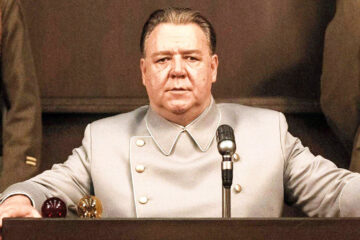Doc unspools storied life of Jewish outsider artist, Nuremberg trials guard Nathan Hilu

By Linda Buchwald, New York Jewish Week
In the documentary Nathan-ism, Jewish artist Nathan Hilu is hardly ever without a Sharpie or crayon in his hand, drawing something from his memories.
Hilu was a Lower East Side native who, as a U.S. soldier at 19, was assigned to guard Nazi war criminals at the Nuremberg trials. The experience left an indelible mark upon him: In the ensuing decades, Hilu processed these memories by obsessively creating art from this time in his life, often repeating the same images, simple figures with words written around them in a messy if compelling scribble.
“I’m not really a big, great artist. I’m a memory man,” Hilu, who died in 2019 at 93, says in the film, which will be screened as part of Dayton’s JCC Film Festival. “That’s where my pictures come from.”
In 2012, Tablet Magazine called Hilu the “most significant Jewish Outsider artist you’ve never heard of.” With the documentary, Israeli-American filmmaker and editor Elan Golod hopes to change that. He spent eight years making Nathan-ism, which chronicles Hilu’s daily life as a lonely, aging veteran and the history of the Nuremberg trials.
The result is a movie that takes us inside the obsessive mind and cluttered apartment of a unique New York artist who is desperate for his story as a witness to one of the most significant trials in history to be heard.
“It’s not that he feels like drawing, he has to draw — it’s a way of communicating,” curator Laura Kruger, who has been credited with “discovering” Hilu, told the New York Jewish Week about Hilu in 2019.
Golod first learned about the artist almost nine years ago when he read an article about a small retrospective of Hilu’s art at Hebrew Union College’s museum that was curated by Kruger. “I was fascinated by the circumstances of his story, but also the dissonance between a very heavy subject matter done in colorful Crayola colors,” Golod said. “That felt cinematic to me.”
Golod envisioned his project as a short film, and at first Hilu, not understanding Golod’s intentions, was hesitant to participate. But after a few phone calls and in-person meetings without the camera, Hilu warmed up to the filmmaker. Golod ended up filming Hilu over the last four years of his life. Each time he visited — usually every week or two — Hilu would show him a shopping bag full of art he had made since their last meeting.
He ended up with more than 300 hours of film of Hilu, who shares with Golod his memories of how well the Nazis were treated in jail, as well as the time Hitler’s chief architect Albert Speer told him that Hitler made a mistake and didn’t have to kill the Jews.
Other talking heads in the film include Kruger; retired counselor for war crimes accountability for the U.S. Department of Justice Eli Rosenbaum; and art journalist Jeannie Rosenfeld, who all weigh in on the importance, volume, and validity of his work.
The film also demonstrates the importance of oral history — specifically, historical events as remembered by those who were there — while also grappling with the fallible nature of memory. As Hilu draws and narrates his often-repeated stories of his encounters with Nazi criminals, he is quick to emphasize that though some of his stories don’t sound true, he insists they all are. As Hilu says in the film, “I am no historian. All I can do is show you my part of history.”
In the film, Golod endeavors to verify Hilu’s stories, albeit with mixed results — largely because a 1973 fire destroyed Hilu’s military records. And yet, even if the details get hazy, Golod insists that Hilu never tried to intentionally dupe anyone, he was simply expressing his version of events as he remembered them. “I think he’s obviously telling his truth,” Golod said.
JCC Film Fest presents Nathan-ism, 7:15 p.m., Thursday, June 20 at The Neon, 130 E. Fifth St., Dayton. $12. Purchase tickets here.
To read the complete June 2024 Dayton Jewish Observer, click here.





